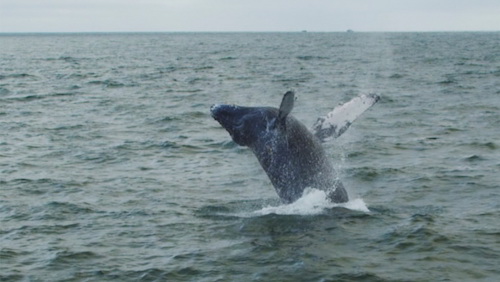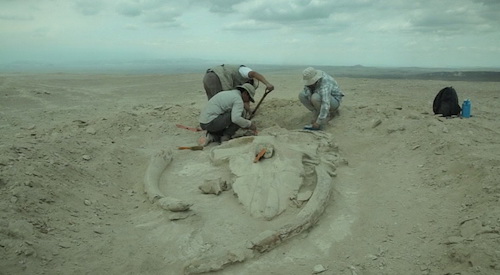 Evolution
Evolution
 Intelligent Design
Intelligent Design
More “Design of Life” Evidence: Whales

Living Waters: Intelligent Design in the Oceans of the Earth shares amazing information about humpback whales: their enigmatic songs, their multiple adaptations for aquatic life that defy the evolutionary mechanism, and the “miraculous web” of blood vessels that refrigerates the male reproductive organs to safe levels for sperm production. All of it defies explanations based on natural selection. But that’s just the beginning when it comes to the largest animals that have ever lived — larger even than the largest dinosaurs (see Brian Switek’s discussion on Slate). Want to see humpback songs as sheet music? The Smithsonian has printouts and recordings.
More About the Male Refrigeration System
The system actually works better when the whale swims hard. How can that be, when the testes are located right between the abdominal swimming muscles? It’s like trying to keep a refrigerator cold between two furnaces.
It works because the blood pumps harder during exercise, allowing more heat to escape into the water through the dorsal fin and tail. The higher volume of cool venous blood then enters the “miraculous web” (Latin rete mirabile, read more here) between the abdominal muscles, where the heat from the arteries is transferred to the cooler veins before entering the testes. It’s a marvelous solution: a “counter-current heat exchanger” (CCHE) mechanism.
As Richard Sternberg and Paul Nelson explain in the film, without both internal testes and the refrigeration mechanism existing simultaneously, natural selection would halt, and whales would have gone extinct. Females, too, have a CCHE to protect the young during pregnancy. Similar CCHE systems are found in other marine mammals such as manatees and seals, providing more unlikely examples of “convergent evolution.”
Conserving Energy
Blue whales are the largest whales, making them the largest animals on earth. How do they sustain their massive weight? An article from NOAA Fisheries says that they target the highest-quality prey in order to maximize energy gain.
These huge animals can span a basketball court and weigh as much as 25 large elephants combined, the article says. But they feed on tiny fish called krill that are less than an inch long. When prey is scarce, blue whales conserve oxygen for deep dives. When the fish are plentiful, they ram through the schools at high speed, a strategy called lunge-feeding. They have their ROI (return on investment) all figured out. By watching tagged blue whales off the California coast, Elliott Hazen and a NOAA research team were able to figure out their optimization strategy.
“The magic number for krill seems to be about 100 to 200 individuals in a cubic meter of water,” Hazen said. “If it’s below that range, blue whales use a strategy to conserve oxygen and feed less frequently. If it’s above that, they’ll feed at very high rates and invest more effort.”
Long-Distance Travelers
Whales have an incredible capacity for long-distance migration. A pygmy blue whale set a new record. Science reports that a female named Isabela that had been photographed at the Galapagos Islands was seen eight years later off the coast of Chile, having traveled 5,200 kilometers, “the longest recorded latitudinal migration made by any Southern Hemisphere blue whale on record.” Most likely this is an annual trip the whales make, over 3,200 miles one-way.
Humpback whales are long-distance migrators too. The Australians have “a cause for celebration” now that conservation efforts have led to a remarkable rebound in their numbers down under, Science Daily said.
Captain Dave Anderson, featured in the Illustra film, often sees humpbacks off Dana Point, California, that have traveled south from Alaska, where they had delighted viewers on cruise ships. PhysOrg reports the first sighting of a humpback near Hawaii on September 29, over a month earlier than normal. About 10,000 humpbacks winter in the oceans around Hawaii, usually November through May. That’s where Anderson got that beautiful drone shot of a humpback with her calf.
Lucky Shot
You may recall the dramatic slow-motion scene in Living Waters of a humpback breaching the surface, rising high above the water and landing on its back with a mighty splash. Lad Allen and Jerry Harned got lucky on that shot. They were filming off the coast of Monterey with their Red Epic high-speed camera, looking for whales. But where are you going to point the camera, when they could be anywhere around the 360-degree horizon?

Harned pointed it out over the featureless water, turned on the pre-roll (a kind of camera memory) hopefully. As if on cue, the whale shot up right in the center of the field. Jerry hurriedly switched on the record button and got the whole sequence in high-definition slow motion — a shot that still gives him chills when he thinks about it. As Paul Nelson said, “the language fails” when you see such wonders.
The Planet Needs Whales
Whales play a vital role in the global nutrient cycle. The Proceedings of the National Academy of Sciences published a special issue in October about large mammals. One of the papers discussed “Global nutrient transport in a world of giants,” describing the oversized role that whales play in spreading nitrogen around for other ecological communities:
Despite their vastly decreased numbers, the important role of whales in distributing nutrients is just now coming to light. Whales transport nutrients laterally, in moving between feeding and breeding areas, and vertically, by transporting nutrients from nutrient-rich deep waters to surface waters via fecal plumes and urine. Studies in the Gulf of Maine show that cetaceans and other marine mammals deliver large amounts of N to the photic zone by feeding at or below the thermocline and then excreting urea and metabolic fecal N near the surface. [Emphasis added.]
The scientists estimate that whales transport almost four times as much nitrogen as terrestrial animals do. They also transport phosphorus and iron.
“Because of their enormous size and high mobility (and despite having many fewer species), great whales might have once transported nutrients away from concentration gradients more efficiently than terrestrial mammals,” the writers say. These nutrients are also “assimilated more rapidly, and contribute to system productivity more directly than on land.”
One of the diagrams in the paper, reproduced by Science Daily, shows the dependency of land animals on this nutrient cycle. Seabirds and “anadromous fish” like salmon carry these nutrients up rivers, where land animals like bears feed on the fish, profiting from the nutrients that whales had brought up from the deep ocean.
The authors even think that whales play a role in carbon dioxide levels that can affect the planet’s climate. They estimate that whale populations have been reduced by 90 percent from levels before the Moby Dick whaling days — raising alarms about ecological damage to planetary ecosystems. This interconnectedness of life raises fresh impetus to preserve these magnificent creatures.
A paper in Nature Communications reports something interesting about whale guts. Baleen whales have microbiomes with similarities to land animals, including humans. This is likely because, although they feed exclusively on marine animals, they have to digest chitin — a polysaccharide from arthropod exoskeletons that is somewhat similar to the cellulose in plants that cows eat.
Like land herbivores, whales also have a foregut that helps pre-digest the polysaccharides. Since there are similarities and differences in the gut microbiomes, though, it’s not clear they successfully tied the findings to the old tale of whale evolution from a four-footed land animal.
“Mammals host gut microbiomes of immense physiological consequence, but the determinants of diversity in these communities remain poorly understood,” the paper begins sheepishly. “Diet appears to be the dominant factor, but host phylogeny also seems to be an important, if unpredictable, correlate.”
Sternberg explains in the film how the whale-evolution sequence is more “artistic license” than demonstrable fact.

Conservation
Captain Dave Anderson has taken an active role in rescuing whales. A thousand whales and dolphins a day, he says, die from being trapped in fishing nets. His Dolphin Safari website tells the story of Lily the gray whale, whose rescue made TV news and inspired an award-winning book Anderson wrote to raise awareness of the plight of marine mammals caught in nets.
Recently, he has been developing a low-cost floating beacon that whale watchers can fasten to nets that whales are dragging along with them. This allows rescuers to find the whale again and cut it free, using a special pole with V-shaped knife that allows the rescuer to cut off the net off without harming the animal.
Sadly, whales and dolphins are also threatened by a growing problem: plastic trash. PhysOrg show a picture of a dead sperm whale on a beach on Taiwan that was found to have plastic bags and fishing nets in its stomach. This may be one cause of the mysterious beachings of whales you hear about from time to time.
Anderson tells about how mylar balloons, let loose by thoughtless partygoers, often wind up in the ocean. Deflated and floating on the surface, they are mistaken for jellyfish, part of the whale’s diet, and can lead to death when ingested. We all need to realize that trash washed down our storm drains can threaten the most magnificent animals on earth.
But let’s end on a happy note. The drones that gave the Illustra team such spectacular aerial photographs of whales and dolphins are proving useful for science. NOAA Fisheries reports that hubcap-sized hexacopter drones are now being used to study gray whales from above. Like humpbacks, gray whales have made a remarkable comeback since 1994 when restrictions on whaling were imposed. With these new aerial monitoring tools, scientists hope to spread this success story to other species that are still endangered.
“Hopefully in the not-too-distant future,” a NOAA marine biologist says, “there will be many healthy populations of large whales to study.” With that, the beauty of their intelligent design will also be preserved for posterity.
The entire “Design of Life Collection” is now available from Illustra Media on both DVD and Blu-ray. These three beautiful films on butterflies, birds, and whales make great holiday gifts.
